Match-up press
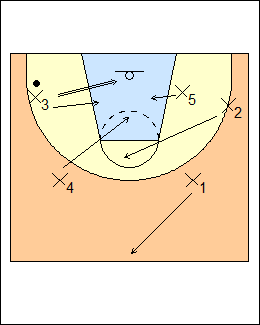 | 1 Converting When team X shoots, X3, X4, and X5 crash the boards in a rebounding triangle, X1 is the long safety, getting back to halfcourt on the shot, X2 is the short safety, getting above the foul line, or above the top of the three-point line if a shooter. X2 can go for long rebounds. For basic defensive transition, defenders pick up their checks from these positions (X2 guards the opposing point guard), optionally X3, X4 or X5 can jam if their check gets a defensive rebound, delaying an outlet pass. See Defence - Transition basics. |
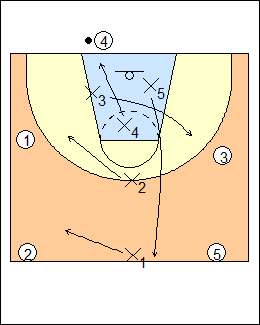 | 2 For a progression, use a match-up press, which starts as a zone then becomes man-to-man. See Defence - Florida match-up press, White and black match-up press. a) On a made basket X4 takes whoever inbounds (some teams do not have a designated inbounder), X2 is ballside, X3 is weakside, X1 is ballside at halfcourt, X5 gets back opposite the ball, and has basket protection. All defenders match up with an attacker (find someone), usually X2 will defend the other point guard, and X5 have the deepest attacker. Switch if attackers cross before the inbounds pass. Options - if 4 runs behind the baseline, X1 mirrors the ball, going side to side - X2 always starts on the left, X3 on the right. Bob Hurley - if you put a tall guard on the opposing point guard he can defensive rebound without a box out (the opposing point guard sprints back to protect deep), with the other four defenders boxing out, this can really control the glass. Doug Porter - low-post X5 is up front so they can transition to offence quickly, defenders find players to match up with in their areas, X1 is ballside sideline, X4 takes away deep but cheats up as far as possible. |
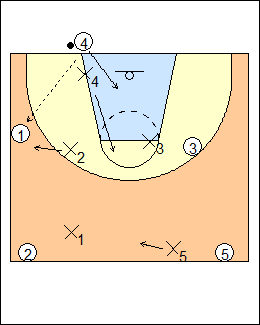 | 3 Fullcourt man-to-man defence on the inbounds pass, see Defence - Fullcourt man basics for options (e.g., trapping). |
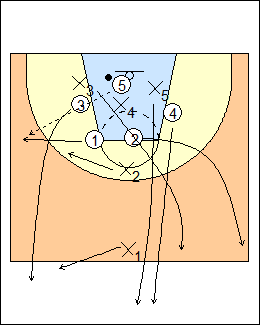 | 4 b) On a missed shot When team O rebounds a missed shot by team X, defenders immediately match up, - X4 jams the rebounder, delaying an outlet pass (or at least matches up quickly) - X2 takes whoever gets the outlet pass, picking up the ball early to slow it down - X5 releases X1, has basket protection, takes the first inside attacker - X1 covers an attacker up the ballside sideline, taking away a headman pass (but goes with any attacker who runs by before X5 can protect the basket) - X3 sprints and finds leftovers, usually weakside. Variation - X5 or X3 releases X1. Options - X2 tries to deny an outlet pass to 1, or make him catch coming back to the ball - X4 follows the outlet pass to trap with X2 - the two closest defenders trap the rebounder. See Defence - Transition basics. Tom Davis - after missed shots, X4 locates the ball and pressures the passer, X2 and X3 retreat to midcourt as they try to find their receivers (with X2 on the left), X1 and X5 take the next two available attackers, consistent with their pressure after made shots. This can be extremely effective against a team that wants to walk the ball up. Doug Porter - continue trapping on missed shots (the goal is maximum pressure all the time), the two closest defenders trap the rebounder. |
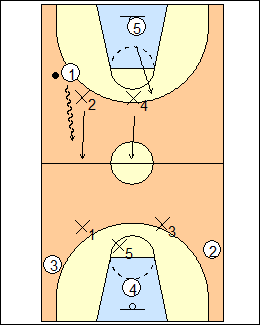 | 5 Basic fullcourt pressure, X4 defends the trailer at ball level, providing help on the ball. Missed-shot and made-shot trapping options are basically the same, e.g. X4 traps off the dribble, or X1 traps from the front, see Defence - Fullcourt man basics. Hoop Tactics - X4 can trap with X2, fake a trap and recover to O5, or run and jump switch. |
